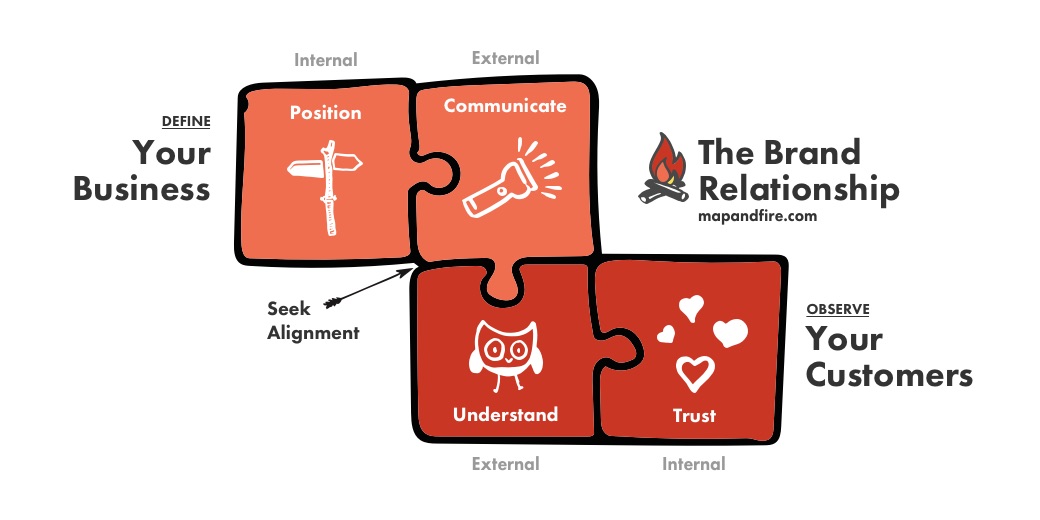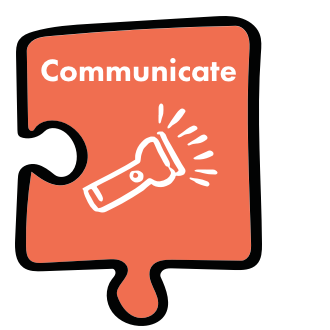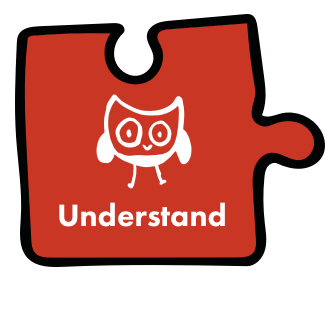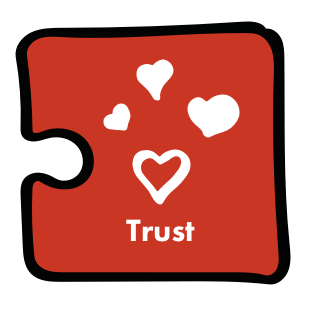
One of the hardest parts of working on your brand comes down to understanding a simple question:
What is a brand?
If you don’t have a clear way to think about your brand, it’s difficult to make meaningful progress building it and improving on it.
Given how many people work on brands and the countless dollars that businesses invest in them, it seems like the concept would have an obvious definition. But the truth is there isn’t one single agreed upon way to define or conceptualize your brand.
If you search around and consume content from those that work in the brand and marketing space you’ll hear definitions like:
- A promise you make to your customers
- The summation of everything you provide to customers
- An experience your business provides
- A mental shortcut for how your customers think about your business
- The reputation of your business
There’s also the common misconception of equating your brand with your logo. We’ve already written about why your Brand definitely isn’t your logo, so you can check that out as well.
But for the other definitions above, they all have elements of truth to them. And while the ideas all make sense in different ways, they’re still very conceptual. They’re hard to visualize.
We wanted a better mental model.
Mental models help us wrap our heads around complex ideas. They quiet the noise of details in order to understand concepts as a whole.
For the concept of a brand, we wanted a mental model that would clarify what it is and make it easier to work on it.
The concept we developed is to think about your brand as A Relationship.
Here’s the image of that model:

The overarching goal of the model is to help you visualize the core elements of your brand and see how those elements relate to one another.
Using it should make it easier to discuss how your brand functions and identify your strengths and weaknesses.
Here’s a breakdown of the pieces.
The Brand Relationship: A Tale Of Two Halves
We created the model as a relationship to highlight that your brand is a connection between two halves:
- Your Business: Defining your unique value and effectively communicating it
- Your Customers: How well they understand your value and trust you can deliver on it
As this shows, it means that you only have direct control over half of your brand relationship — your business.
Your customers control the other half.
They’ll form an idea in their heads around what your business is and whether they want to engage with it based on what you present.
However, while you can’t control what your customers think, you can learn about and analyze their opinions and actions to help evaluate your brand’s effectiveness.
Let’s dig into the pieces of each half to see what they represent and why they’re important.
Your Business: Position

Core Theme:
Are you clear on the direction and unique place your business has in the market?
What It Includes:
- Big Picture Direction: Purpose, Vision, and Values
- Positioning: Customer Needs, Competitive Landscape, Offering Alignment
Why It’s Important:
It shows that you understand why your business exists, where it’s headed, and how it uniquely serves the needs of your customers.
These are the most fundamental elements of your brand strategy. They inform your products and services as well as the benefits you provide to your customers.
Evaluate Strengths and Weaknesses:
- Is your team clear on the direction of the business?
- Does your team operate consistently in its behaviors and actions?
- Is it clear how your product or service stands out in the market?
- Does your product or service align with the most important needs of your customers?
Your Business: Communicate

Core Theme:
Are you able to convey your unique value in a way that’s clear and emotionally compelling?
What It Includes:
- Attributes: Tone of Voice, Brand Archetype, Visual Identity
- Marketing: Messaging and Design
Why It’s Important:
It’s how you express the value your business provides to your customers. Without clear communication your business can’t effectively engage your customers.
Evaluate Strengths and Weaknesses:
- Is everyone on your team able to articulate a clear story about what your business does and why it’s unique?
- Do your messages use a tone and style that’s suited to your customers’ needs?
- Are your marketing materials consistent across all the different channels you use?
- Do your marketing materials speak to the motivations and outcomes of your customers?
Your Customers: Understand

Core Theme:
Can your target customers quickly and easily understand how you improve their lives?
What It Includes:
- Awareness: Recognizing your business and knowing the value you provide
- Engagement: Having some meaningful interaction with your business
Why It’s Important:
This is where every customer relationship starts. It’s the first sign that the customer understands what your business provides so that they can evaluate if it suits their needs.
When this area works it’s a signal that there’s alignment in your brand relationship. It means that your value is clear and your communication is effective.
Evaluate Strengths and Weaknesses:
- Do your target customers engage with your product or service in some way?
- Do your target customers respond to your marketing efforts?
- If they don’t engage do you understand why?
Your Customers: Trust

Core Theme:
Do your customers believe that your business will provide the value they need and improve their lives in the long run?
What It Includes:
- Conversion: Becoming a paying customer
- Loyalty: Staying on as a customer for an extended period of time
- Evangelism: Spreading the word of your business to others
Why It’s Important:
For any business to last and thrive for the long haul, it needs customers who stick around and then evangelize the brand on behalf of the business.
Your business has to deliver a high level of value for a long period of time to achieve this. Once you do, it can lead to sustained growth.
Evaluate Strengths and Weaknesses:
- Are you able to convert target customers consistently?
- Do customers stick around or do you struggle with churn?
- Do your customers recommend you to others?
Seeking Alignment
The last note on this model is the point where the two sides of the relationship, your business and your customers, come together.
Ideally you want this alignment to be as tight as possible. It means that there’s little to no gap between the unique value you provide and how you communicate it, and the ability of your customers to understand how you make their lives better and trust it.
The alignment won’t always be perfect. And the alignment won’t be exactly the same for every customer. But if that alignment is too far off, your brand relationship won’t be effective and your business won’t survive.
Start Working On Your Brand Relationship
The point of a mental model is to get out of the weeds of an idea in order to gain a big picture understanding.
By using the Brand Relationship model, you can zoom out on your brand and get a new perspective on it. It helps you avoid working on bits and pieces of your brand wondering how each will move the needle.
By looking at each core section and evaluating them one-by-one, you can spot areas that need work and build them up over time.
This is a process that will strengthen your brand and set your business up for the long haul.

Get Help Building Your Brand
If you’re ready to build stronger connections with your customers, reach out for a free consultation. We’ll help you transform your best business thinking into an actionable, shareable, growth-oriented guide. Click below to learn more about the Brand Guidebook process.

